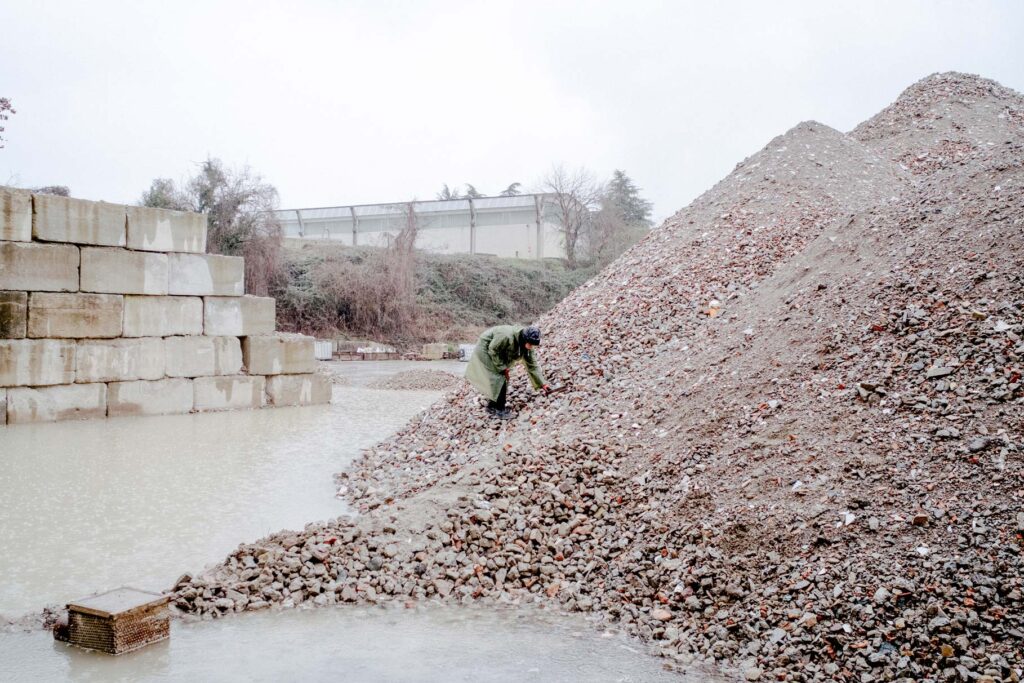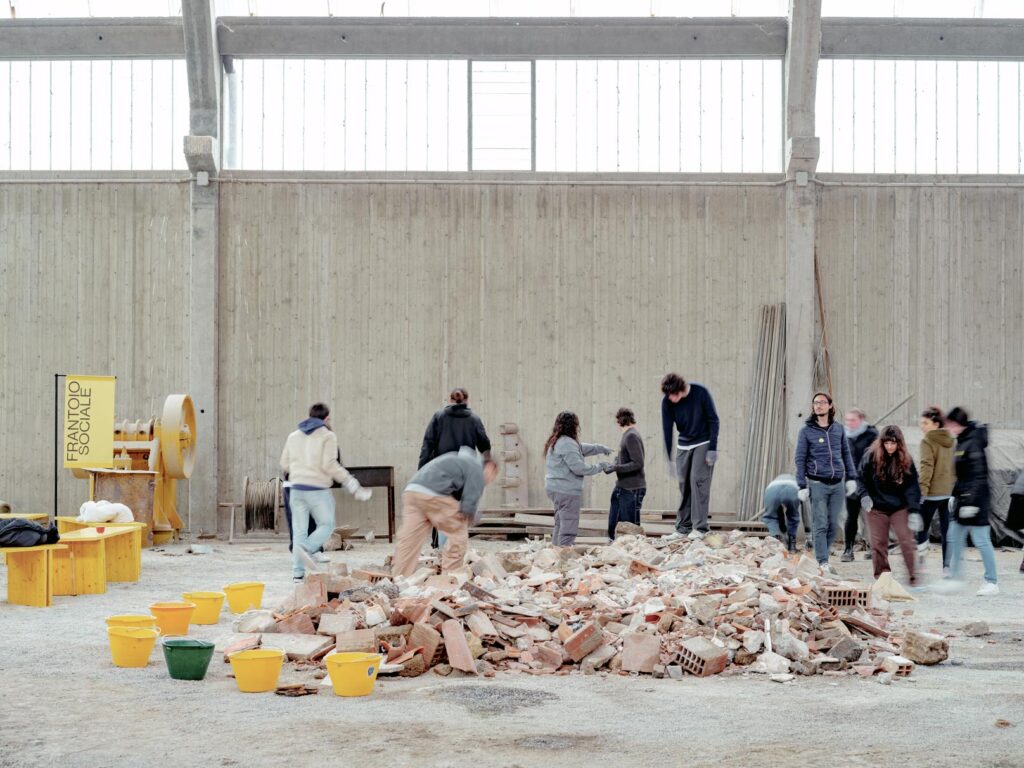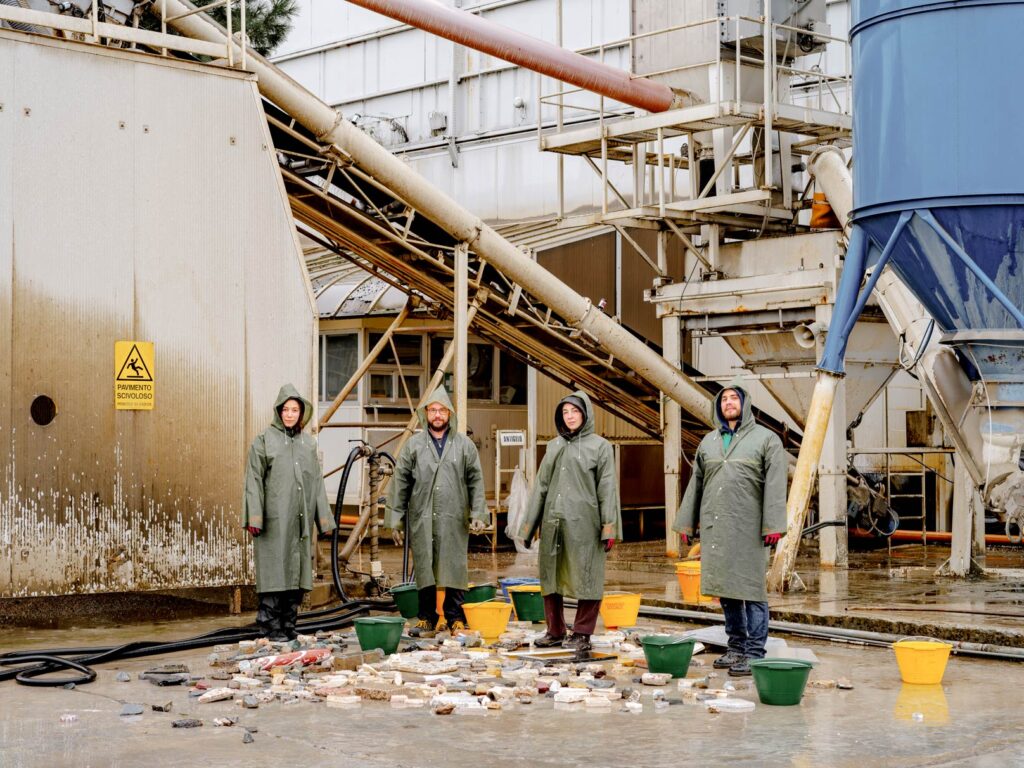“Transforming design from an expert-driven process focused on objects and services within a taken for granted social and economic order toward design practice that are participatory, socially oriented, situated, and open ended and that challenge the business-as-usual mode of being, producing and consuming. It highlights design frameworks that pay serious attention to question of place, the environment, experience, politics”*
Arturo Escobar, Designs for the Pluriverse: Radical Interdependence, Autonomy, and the Making of World, p. 27
A pile of aggregates, a group of people, a few tools, a crushing machine and benches made out of construction planks. We started from here and, sitting in a circle on the latter, began to dialogue and explore the sense of the Frantoio Sociale project. A two-day workshop was held together with the students of the G. Carrara Academy of Fine Arts in Bergamo within the spaces made available by Nuova Demi in the Zanica quarry. We began with a discussion on circularity, the value of materials, what we do or can do, as well as past, present and future worlds—not through a lecture or readings from texts, but rather starting from the basics of the scientific method: observation and experimentation.
The benches later became the worktables we would use to collect the material gathered, sort it by type and color, grind it down, and finally catalogue it by grain size: pink marble, white marble, black marble, brick, slate, tuff. Everyone had a different task. Some participants were responsible for finalizing the sorting of the remaining materials for cataloging and storage in the Frantoio Sociale archive. They did this using sieves of various grades. Others were engaged in building the formwork inside which aggregates of different sizes were poured, bound together using white cement, which had been prepared by another small group.
This research of ours started out almost ten years ago, when we embarked on a series of studies that allowed us to explore and act in the places of urban transformation, where everything begins and at the same time everything ends.
Suffice it to say the production of special non-hazardous waste, in Italy in 2021, stands at 154 million tons, of which 50.6 percent is special construction and demolition waste from companies operating in the construction sector. A sector that has seen significant growth since 2021 due mainly to construction sites for housing supported by generous government incentives for the renovation of buildings aimed at energy upgrading. Compared to 2018, the first year we monitored, in which Italy recorded a total of special construction and demolition waste of about 59 million tons, 2021 saw recorded a 29 percent increase with as much as 77.218 million tons: drastically high numbers.1 Thus, it is horrendous to think the storage of inert waste also calls for the use of dedicated spaces used as storage facilities, which are anything but transitory in nature given the increasing production of material, and thanks to which the perception of the surrounding landscape will be radically altered. Here we experienced and understood how the big problem, the obstacle that does not allow the circular system to win over the linear one, is not technical—there is more to it.
Credits: Photo Riccardo De Vecchi
For millennia, human beings have been building tools, extracting materials, adapting them to their needs, assembling, alloying, mixing and reusing, in a continuous quest for technological perfection. The development of our society has been predominantly circular: everything was reused and transformed, from mammoth bones to Egyptian columns.
Even the Phoenicians used to use dust and fragments of earthenware mixed with sand and lime, as shown by the findings at the archaeological sites of Tell el-Burak in Lebanon (7th century BCE), one of the most ancient finds of what we now call earthenware. Later perfected by the Romans, who used it as a waterproofing agent for tanks or as a finish for masonry, cocciopesto consists of the mixture of lime, sand, and crushed cocci: amphorae, bricks, tiles, and roof tiles. A relatively easy material to make that we might choose as the earliest example handed down to us of the circular economy in construction. This technique developed with various developments and expressions in various regions of the Mediterranean: the closest to us are Greece, Sicily, and Herculaneum. In some of these finds, the addition of marble granulates, stones, and pebbles is clear, making the mixture more resistant and stable, and adding an aesthetic component that finds its greatest expression in the Venice of the 1500s, where what we now know as Venetian-style flooring began to spread and be perfected. These simple examples are a reminder of how the practice of recycling is part of us and our historical heritage. The reason why the economy of the last two centuries has been based almost entirely on an extractive and linear economy is to be found elsewhere—certainly not in the realm of technical possibilities or systems but in the cultural realm. As Sabine Oberhuber and Thomas Rau recount in their book Materials Matters,2 over the past century the individual has undergone a process of de-emphasizing the product life cycle in favor of a capitalist cycle marked by substitution rather than reuse/repair. Take, make, waste. This desensitization, in addition to having brought increases in sales and thus an increase in the production of objects—with a constant need for raw materials—has also redefined the role of the consumer, fueling the desire to own new products and consequently diminishing interest in the possible cycle of material reuse.
The Academy students who participated in the workshop experienced the process—which we started about three years ago with the creation of the Frantoio Sociale project—of exploring construction sites, quarries, urban mines, places “of” and “in” transformation. Through this project, we tried to provide a possible alternative to the linear system, seeking to alter certain contemporary paradigms and taking a solid archaic basis as an example. The aim is clearly to popularize and spread circular and collaborative development practices.
The project draws inspiration from the world of agriculture, such as olive presses intended for the production of olive oil, and social wine cellars where members would bring the produce of their vineyards. The lowest common denominator of these activities is the central presence of a machine with which small entities transform olives or grapes into oil and wine “of and for all”.
These archaic environments, besides being transformative places, were at the same time social spaces, where people met, chatted, socialized, and shared moments together.
Based on this archetype, we developed the structure of our project, which attempts to make places undergoing transformation into social spaces: collaborative, open, horizontal environments in which a group of people work, transform, exchange information, socialize and contribute, through collective action, to change the crazy contemporary development model.
Frantoio Sociale thus turns urban mines into sites and territories in transformation, as an itinerant and evolving project that relies mainly on two key elements: the first is the presence of a portable crushing machine. Inspired by the aforementioned examples, we place emphasis on a new aspect, i.e. the transportability of the tool so as to easily move to the site to wherever the material is present, and so activate the transformation process in a different space each time. The second key element is the multi-purpose, yellow ‘construction site’-style setup that adapts to any type of space with a system of modular elements capable of becoming benches, tables, bookcases, displays, etc.
This project may be defined in many ways: a research which allows us to study and explore the issue of circularity in construction; a training event, for us and for all the entities that from collaborate with us on each project, such as companies, universities and institutions. Frantoio Sociale is also a project based on the sharing of practices, knowledge, and opportunities, always designed to operate in dialogue with other realities. In this case, it was part of Studio Ossidiana’s Massi Erratici project, with which together—like a team of archaeologists exploring the present—we dug up, recovered, selected, cleaned and crushed the various types of marble and granite that are now part of this new domestic landscape to be found at GAMeC.
Studio GISTO, Hund Studio
The project Massi Erratici by Studio Ossidiana in collaboration with Frantoio Sociale is supported by Architetture Sostenibili per i luoghi della cultura, promoted by the Directorate-General for Contemporary Creativity of the Italian Ministry of Culture
Note:
1 ISPRA Istituto Superiore per la Protezione e la Ricerca Ambientale, ESPORTAZIONE DEI RIFIUTI SPECIALI NON PERICOLOSI E PERICOLOSI https://indicatoriambientali.isprambiente.it/it/rifiuti
2 Sabine Oberhuber, Thomas Rau, Materials Matters. L’importanza della materia – Un’alternativa al sovrasfruttamento, Milan: Edizione Ambiente, 2019
Concise bibliography:
Jared Diamond, Armi, acciaio e malattie. Breve storia del mondo negli ultimi tredicimila anni, Turin: Einaudi, 2014
Richard Sennett, Together: The Rituals, Pleasures and Politics of Cooperation, Yale: Yale University Press 201
Valerio Borgonovo, Silvia Franceschini (eds.), Global Tools (1973–1975). Quando l’educazione coinciderà con la vita, Rome: Produzioni Nero, 2018
Arturo Escobar, Designs for the Pluriverse: Radical Interdependence, Autonomy, and the Making of World, Durham: Duke Univ. Press, 2018
Alberto Pireddu, Macerie e calcestruzzo, diario di una ricerca, Siracusa: LetteraVentidue, 2019
Marco Armiero, L’era degli scarti, Turin: Einaudi, 2021

















